Fontaine-de-Vaucluse is a charming village lying on the bank of the Sorgue River. The locality was built around its source in a dead-end valley at the feet of the Vaucluse plateau. Named after the famous and abundant water source nearby, it is surrounded by chalky hills 230 to 240 metres high. The village is located near the hilltop villages of the Luberon, which makes it a prime tourist destination.
Watch this short video on the Luberon!

Pierre at Fontaine-de-Vaucluse © French Moments
We visited Fontaine-de-Vaucluse on a beautiful sunny day in May. Our visit lasted half a day. However, we could have spent a whole day there if we had had time to go up to the castle and spend more time visiting the museums and paper-making workshops.
I strongly recommend that you avoid the peak season if possible (July-August). It is better to visit the village on a nice weekday in spring or autumn. There will be far fewer people and you can enjoy the site peacefully (and park your car easily!)
Plan your trip to Fontaine-de-Vaucluse
- 🛏 Find the best accommodations in the Luberon on Booking.com
- 🚙 Rent a car in Avignon or Marseille-Provence Airport
- 🙋♀️ Get the PASS CÔTE D'AZUR and take your pick from more than 100 amazing experiences!
- 🤩 Visit the beautiful Provençal region of Luberon
- 🚐 Join a 6-hour tour of Lourmarin, Bonnieux, Roussillon, and Gordes by air-conditioned minibus
- 🥗 Experience a black truffle hunting tour in a Luberon plantation
- 📚 Read the DK Eyewitness Provence and the Côte d’Azur Travel Guide
- 🗺 Download the touristic map of Fontaine-de-Vaucluse
- 🚻 Public toilets are located near the town hall (mairie) and by the car park on avenue Robert Garcin.
- 🚗 The car parks are located in the village and are subject to a charge. More info...
The name of a French département
The name of the commune comes from the Latin “Vallis Clausa”, meaning the enclosed valley. In Provençal dialect, it's called Vauclusa or Vaucluso.
It gave its name to the Vaucluse département when it was created in 1793.
Until 1946, the commune was called Vaucluse. That year, it officially changed its name to Fontaine-de-Vaucluse in reference to the water source nearby and to avoid confusion with the département's name.
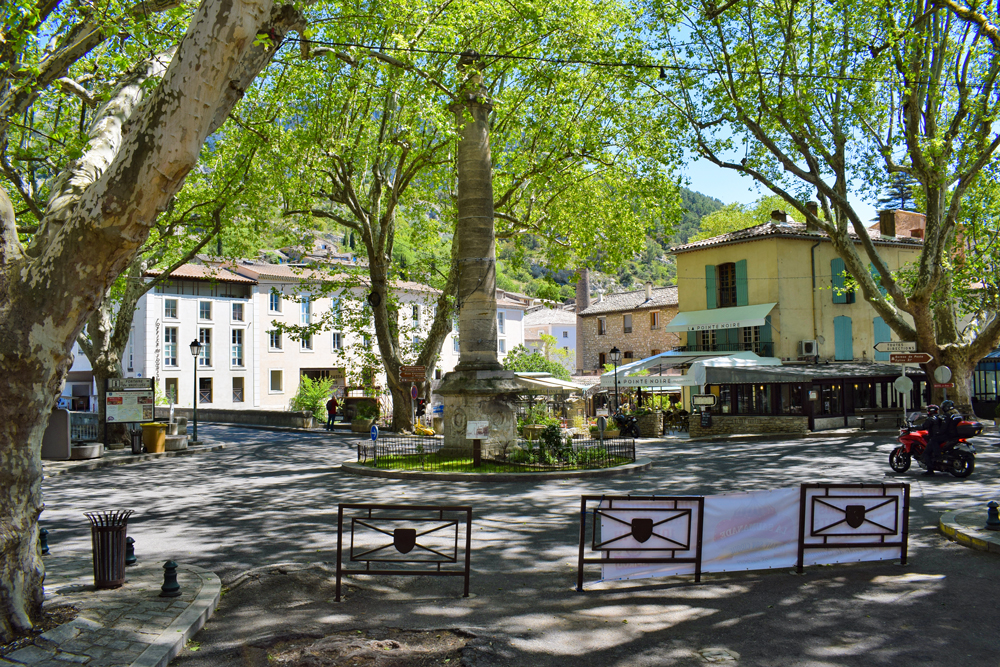
The central square of the village © French Moments
The legend of the fountain's secret
This legend written by Frédéric Mistral tells the story of a minstrel, Basile, who was asleep on the way to the fountain when he saw a nymph appear.
The old minstrel Basile, who had gone off to make the girls of Isle sur Sorgue dance, fell asleep in the shade one hot day on the Vaucluse pathway. A nymph appeared, who, as beautiful as the clear wave, took the sleeper's hand and led him to the edge of the basin where the Sorgue flowed.
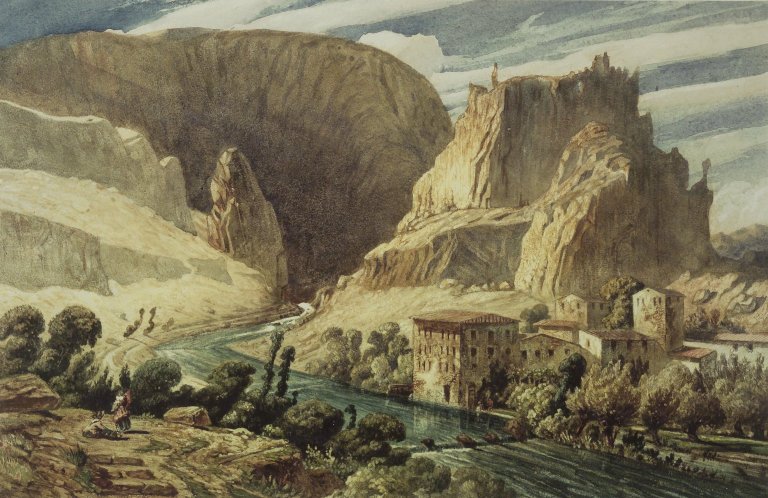
Fontaine-de-Vaucluse by Paul Huet circa 1839
Before them the water opened up and let them descend between two walls of crystal liquid to the bottom of the abyss.
After a long subterranean race, the nymph, in the middle of a smiling meadow sown with supernatural flowers, stopped the minstrel in front of seven large diamonds. Lifting one of them, she made a powerful jet of water gush out.
Here, she said, is the secret of the spring of which I am the guardian, to swell it, I remove the diamonds, at the seventh the water reaches 'the fig tree which only drinks once a year' and she disappeared, waking Basil...
What to see in Fontaine-de-Vaucluse
Watch my guided walk of Fontaine-de-Vaucluse
A 36-minute video that starts at the church of Fontaine-de-Vaucluse before reaching the source of the Sorgue, visiting the gardens of Petrarch and climbing to the perched castle.
The Romanesque church
The Church of Saint-Véran-Sainte-Marie occupies the site of a pagan temple dedicated to a water divinity.

Church of Fontaine-de-Vaucluse © French Moments
Born in Vaucluse, Véran was bishop of Cavaillon and died in 590 during the Council of Arles. The crypt houses the sarcophagus of the Saint.
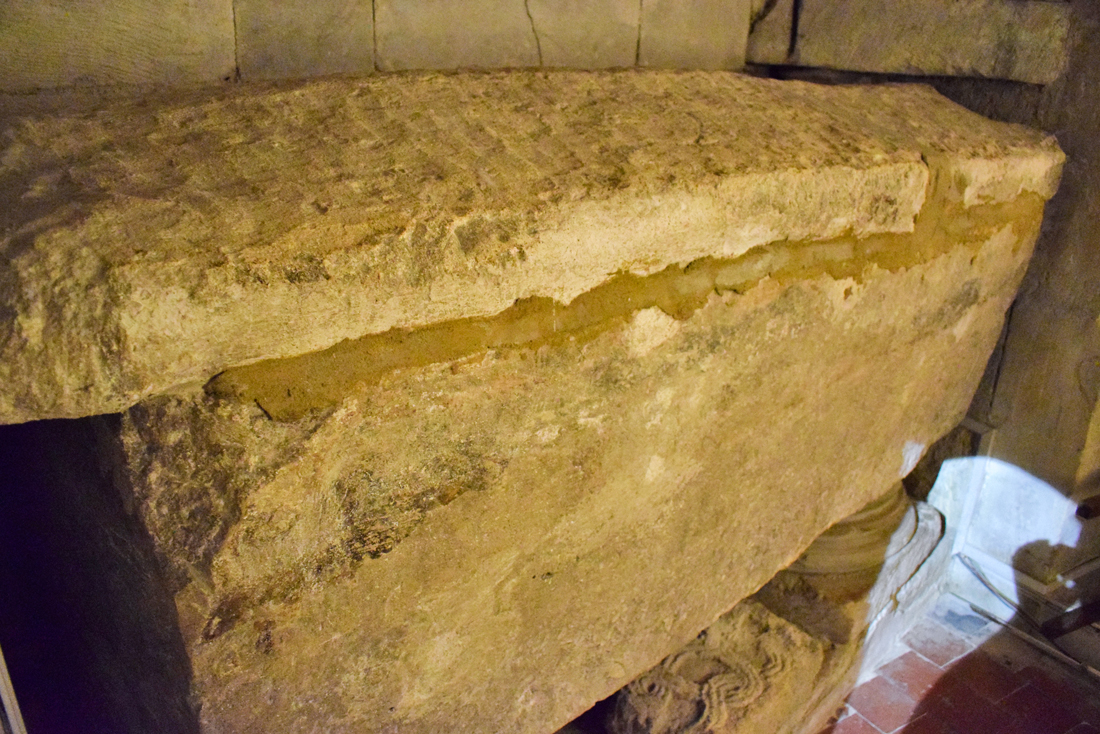
The tomb of Saint-Véran © French Moments
The church is in the Provençal Romanesque style of the 11th century, and is one of the oldest in the diocese of Cavaillon.
It is a small Romanesque building, with a single nave covered by a semicircular vault with a cul-de-four apse.
The sanctuary is remarkable for its simplicity and hides many treasures, including a copy of a painting by Nicolas Mignard (1661) and an altar table carved from marble dating from Roman times.
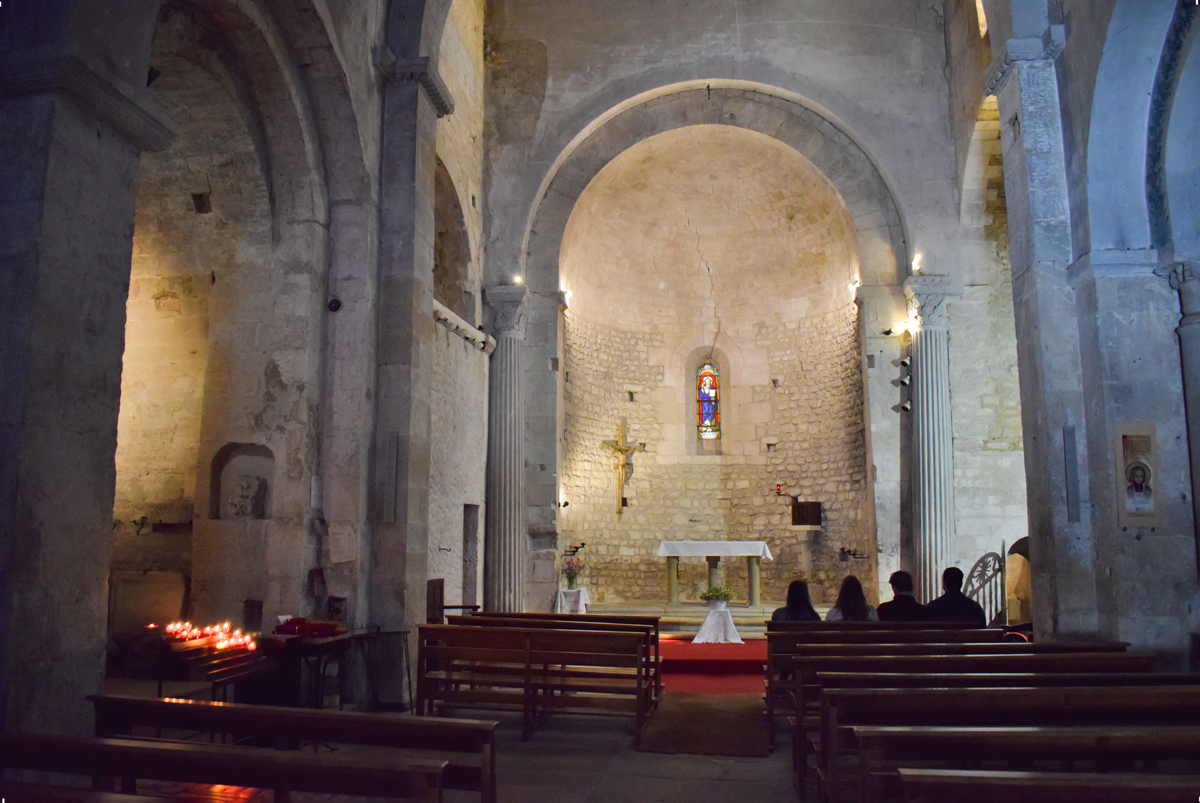
The interior of the church © French Moments
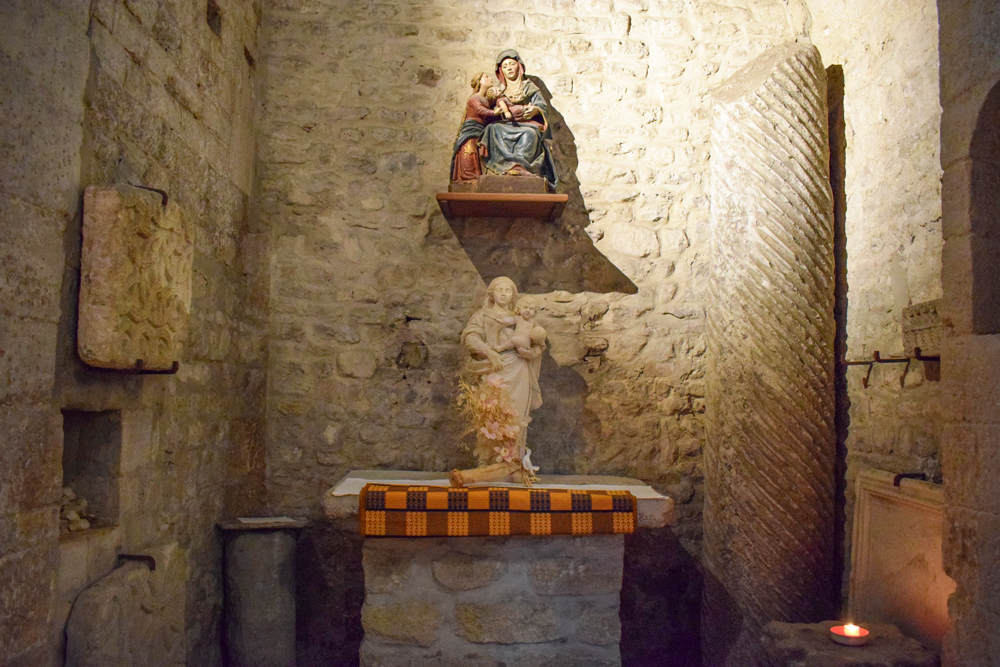
Statues in the church © French Moments
The legend of Saint-Véran and the Coulobre
The legend says that in the 6th century, Saint-Véran settled as a hermit in this remote valley.
The source was the lair of a terrifying dragon, the Coulobre.
Saint-Véran chased the dragon away, which fled to the Alps, near the village of Saint-Véran.
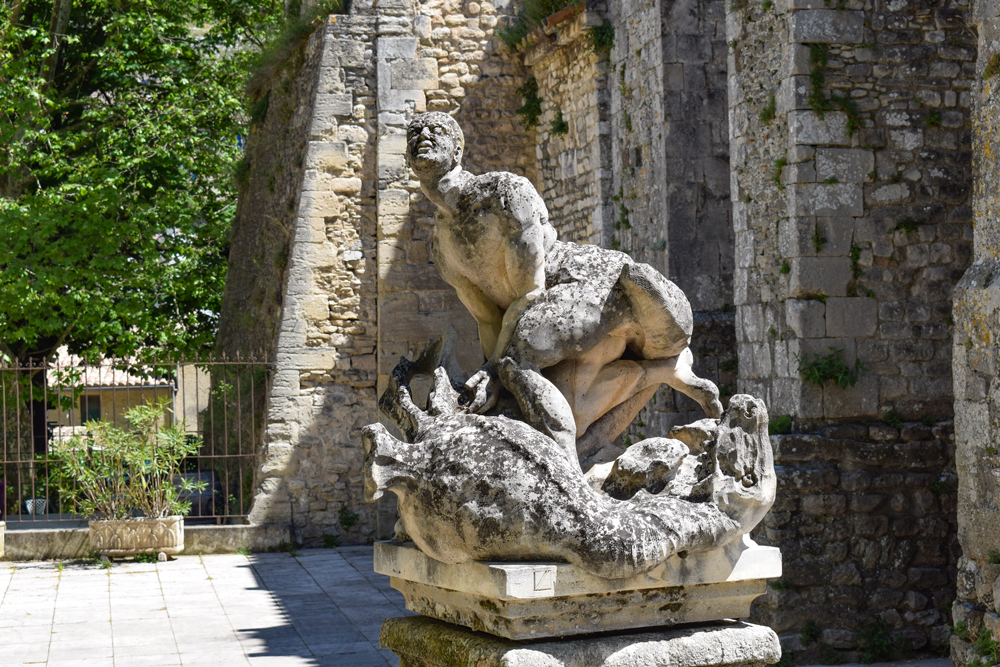
Saint-Véran and the Coulobre © French Moments
This miracle, which saved the valley's inhabitants, made Saint-Véran famous, and he agreed to become the bishop of Cavaillon.
It's interesting to note that other similar legends exist in France, such as the Graoully defeated by Saint Clement in Metz, or the Gargouille slain by Saint Romain in Rouen.
A fountain-statue depicting Saint-Véran slaying the Coulobre stands in front of the church.
Place de la Colonne
The granite column that stands in the centre of the Place de la Colonne was built opposite the fountain's chasm in 1804 for the 500th centenary of Petrarch's birth.
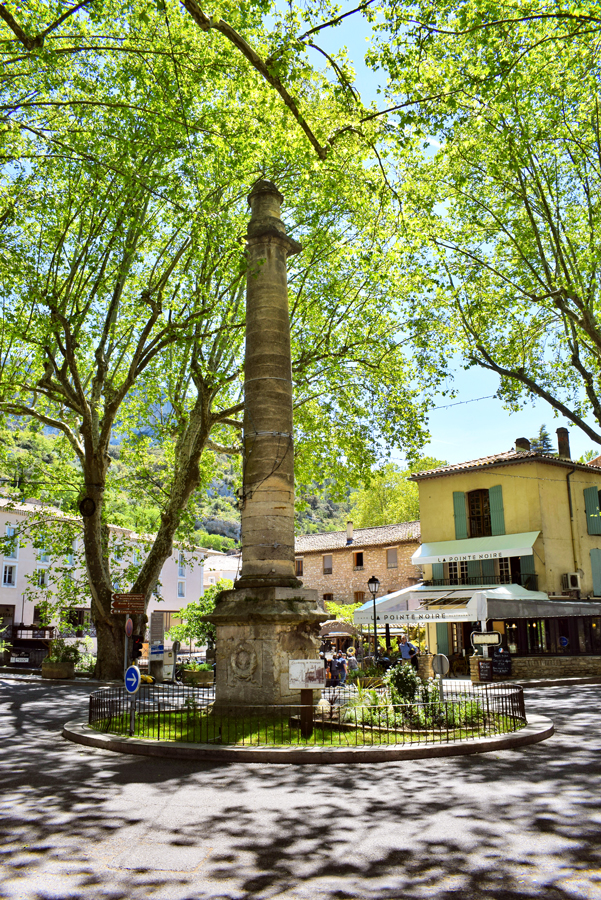
The pillar of Petrarch in Fontaine-de-Vaucluse © French Moments
In 1827, it was transferred to the centre of the village, to the Plantade area, which has since become the Place de la Colonne.

Place de la colonne © French Moments
Also, the town-hall borders the square.
Although Fontaine-de-Vaucluse is not a town, it bears the inscription “Hôtel de Ville” (or town hall). Indeed, the commune has fewer than 600 permanent residents.
The letters RF stand for “République française” or “French Republic”.

The town-hall of Fontaine-de-Vaucluse © French Moments
Climb the outside stairs to the first floor to enjoy a beautiful view of the shady square.

The view from the town-hall © French Moments
Next to the town hall is a drinking water fountain which was dedicated to a healing god.
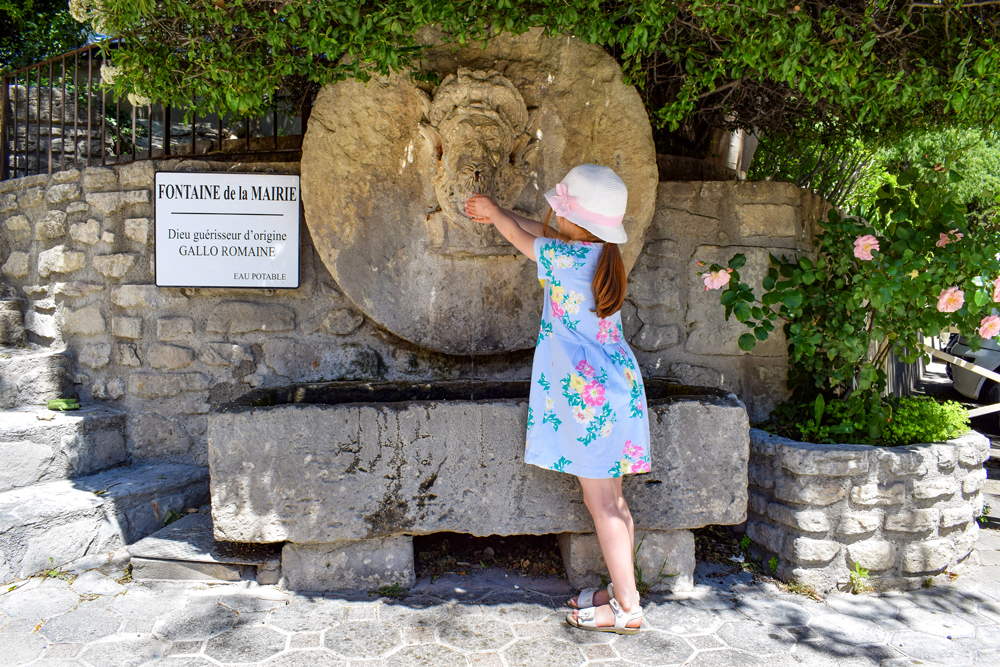
Aimée at a fountain in Fontaine-de-Vaucluse ! © French Moments
The bridge and the waterwheel
The shady square of Place de la Colonne is adjacent to the bridge over the Sorgue river. It offers one of the most beautiful views of Provence.

The bridge of Fontaine-de-Vaucluse © French Moments

On the bridge spanning the Sorgue © French Moments
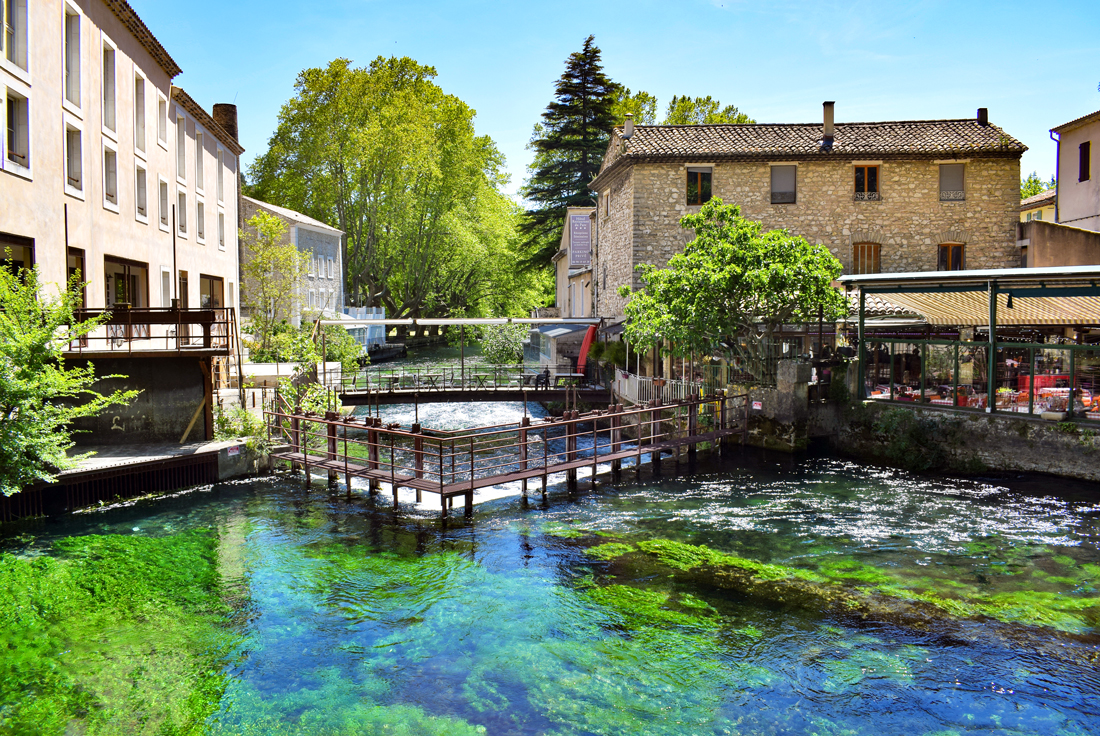
The bridge of Fontaine-de-Vaucluse © French Moments
The waterwheel (roue à aubes) and chimneys of the old factories are witnesses to the industrial era of Fontaine-de-Vaucluse.
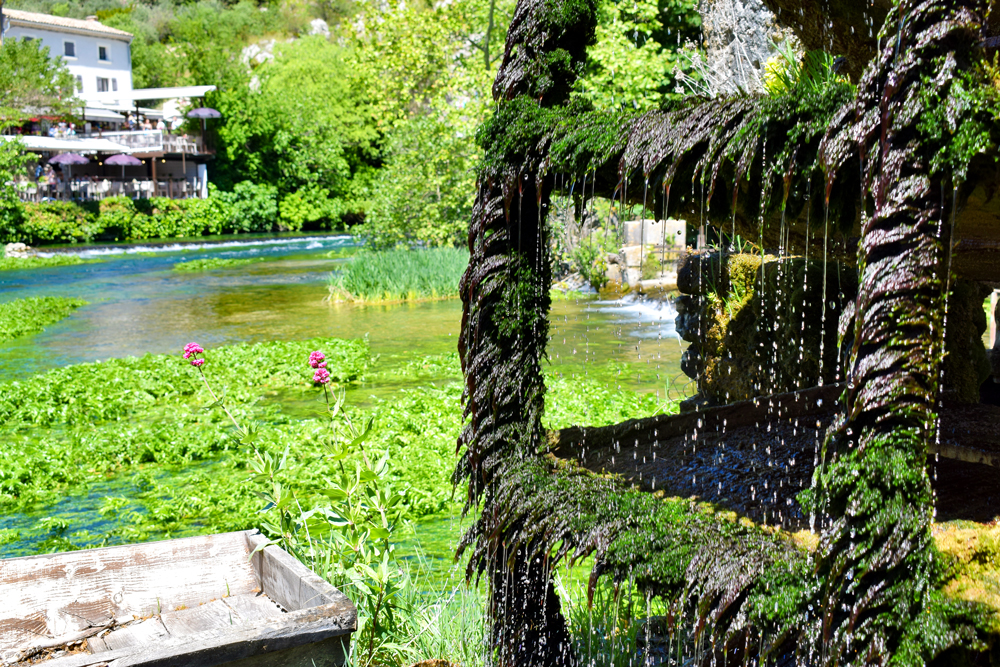
Detail of the waterwheel © French Moments

A waterwheel near the bridge on the Sorgue © French Moments
The paper mill
The paper mill (moulin à papier) still makes paper in the form of rag as it did in the 15th century. The Vallis Clausa gallery, which also contains numerous craft shops, is worth a visit.

Entering the paper mill © French Moments
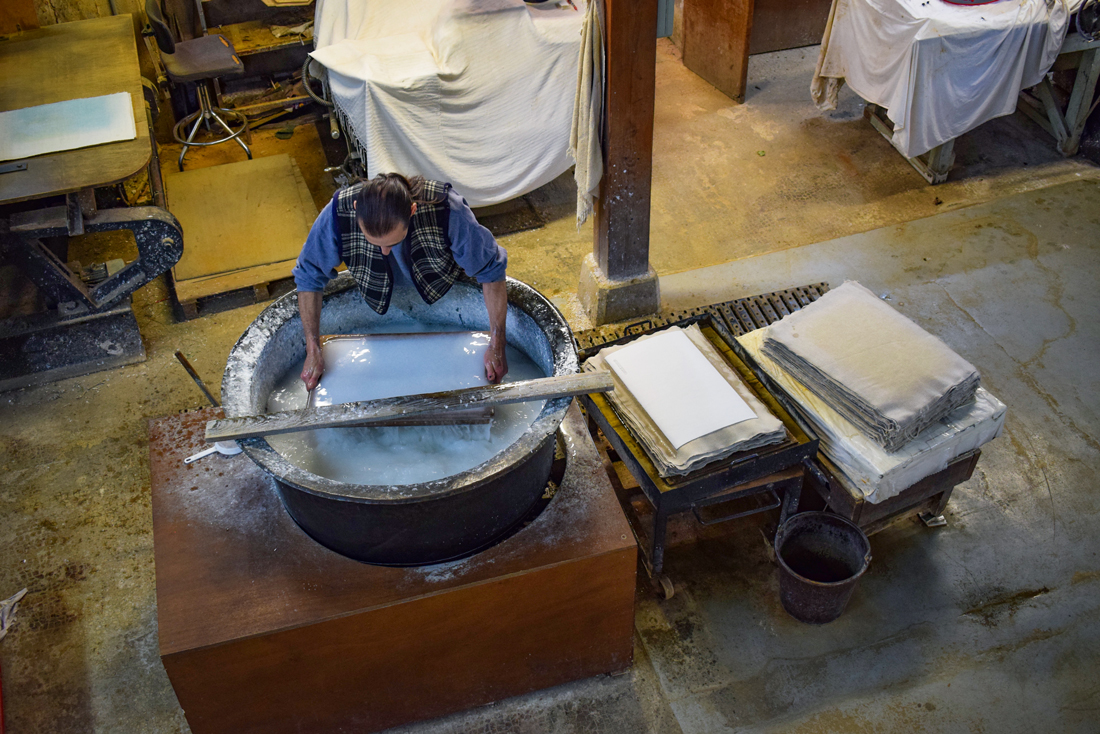
Making old-style paper © French Moments
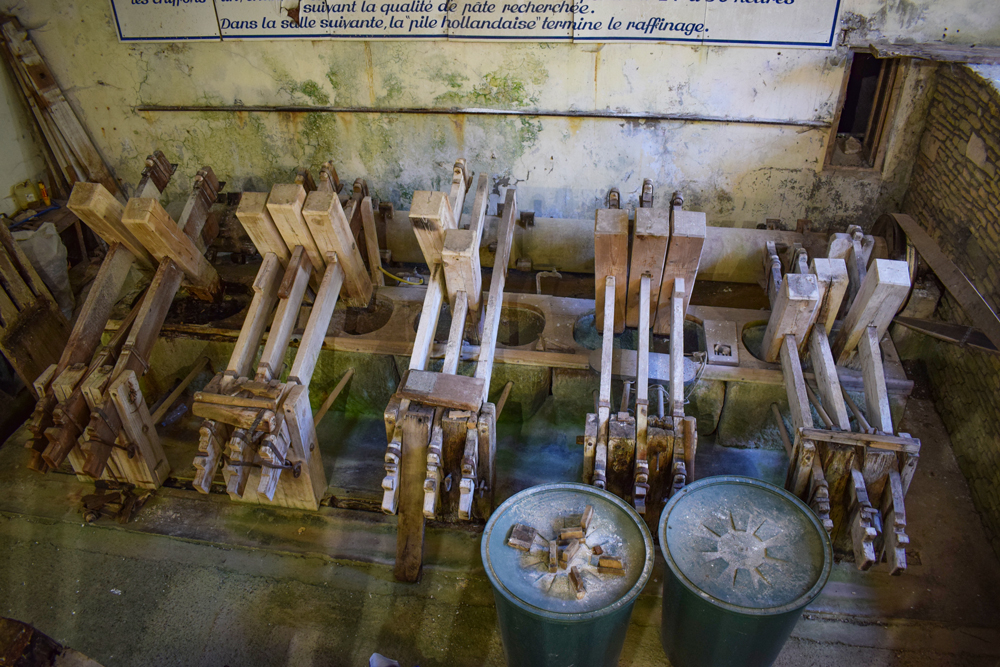
The paper factory © French Moments
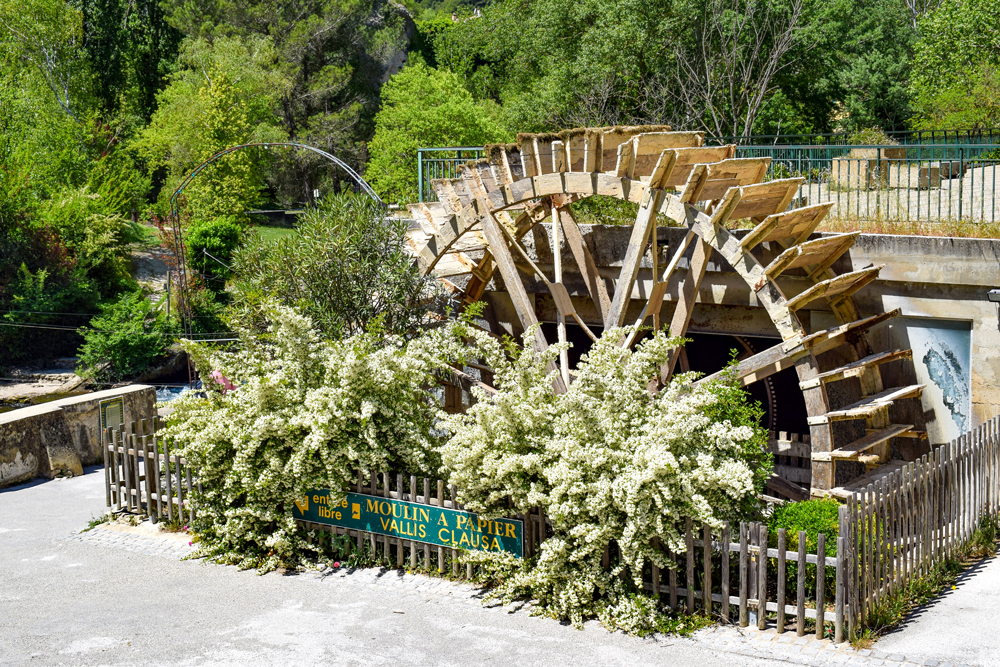
The old paddle wheel of the Paper Factory © French Moments
The Right Bank of the Sorgue
On the other side of the bridge is a cluster of old houses with colourful facades. This area gives access to the Petrarch Museum and to the path that leads up to the castle.

The right bank of the village and its colourful façades © French Moments
To access the "world of Petrarch", enter the tunnel. This is the Passage Arquà Petrarcha, the name of the Italian village where Petrarch died in 1374.

Passage Arquà Petrarcha © French Moments
On the other side, you'll reach the house of Petrarch.
The Museum-Library of Petrarch
The François-Pétrarque Museum-Library occupies a house which might have been built on the site of the house where the poet lived.
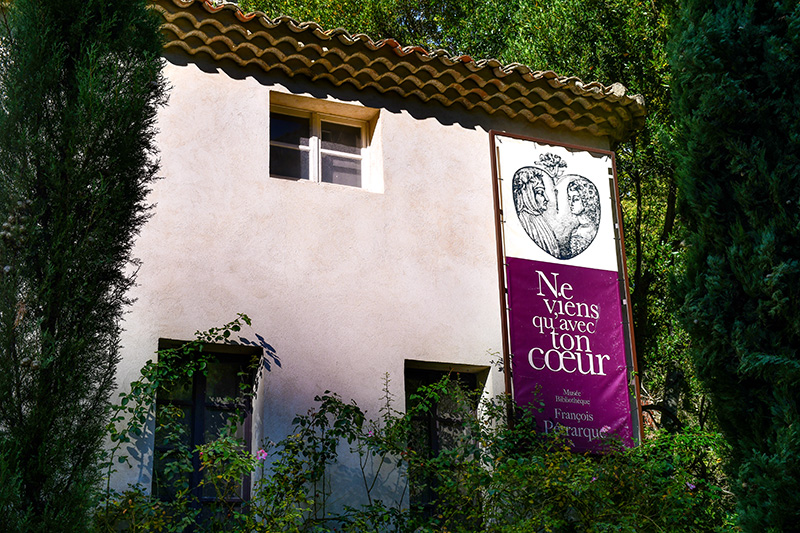
Musée Petrarch © French Moments
The museum exhibits drawings and prints on the theme of Petrarch and Laura of Sade as well as old editions of the poet's works and those of his successors.
Petrarch, the great Italian author
Francesco Petrarch is among the first great authors of Italian literature.
He is remembered for the perfection of his poetry, which versifies his love for Laura de Sade.
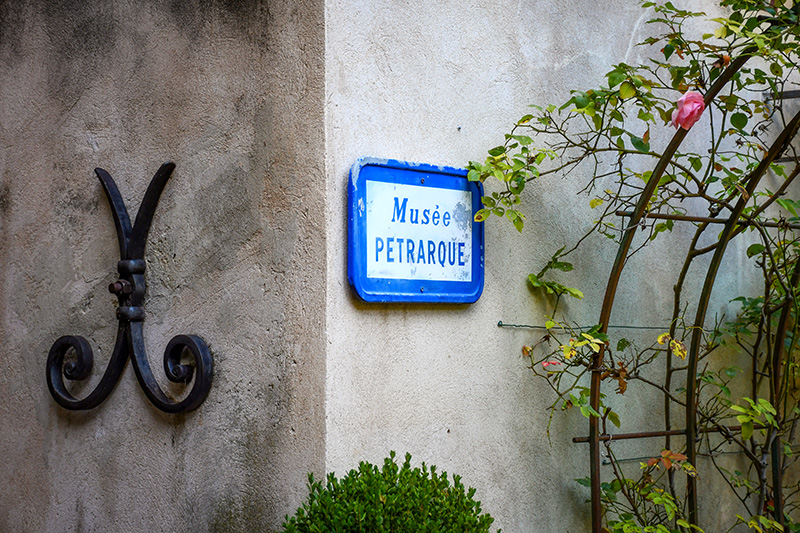
Musée Pétrarque © French Moments
It is in Fontaine-de-Vaucluse that the eternal lover of Laura regularly came to listen to "the hoarse voice of the waters".
From 1339, Fontaine-de-Vaucluse was the favoured residence of Petrarch, as he wrote:
"The very illustrious source of the Sorgue, long famous in itself, has become even more celebrated by my long stay and my songs."
His servant Raymond Monet taught him the art of fishing for trouts, cultivating his garden, and hunting game.

Petrarch Gardens © French Moments
Petrarch's departure from the village
The Italian poet left the village for good in March 1353 and donated his house to the sons of his servant, who had just died, to offer hospitality to his friends visiting the place.
However, on Christmas Day of that year, a band of looters entered the village and pillaged and burned it. In the event, Petrarch’s house was also burned down.
Then, the remote valley fell into oblivion after this attack and Petrarch’s departure.
Considered a wild place, it was little frequented in the 16th and 17th centuries.
It was not until the end of the 18th century that the source and the valley were rediscovered.
Francesco Petrarca, known as Petrarch
Francesco Petrarca, known as Petrach (Pétrarque in French) was born on 20 July in Arezzo. He was the son of Ser Petracco, a notary in Florence.
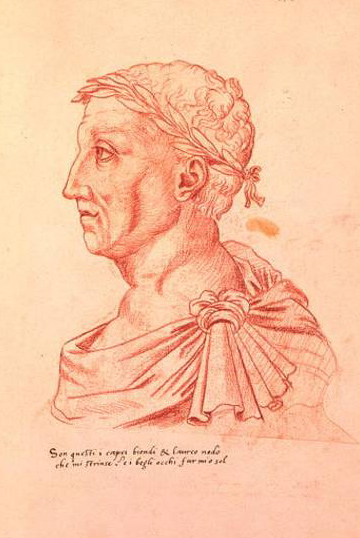
Petrarch
Petrarch lived the first seven years of his life in Tuscany but then followed his family to Avignon where his father had to leave.
Following his father's wishes, he studied law for four years in Montpellier and two years in Bologna.
In 1324, the death of his father freed him from this tedious obligation. Having befriended two members of the Roman Colonna family, he was introduced to the papal court in Avignon, where he met with great success due to his lively mind and his charm and beauty.
He settled in Fontaine-de-Vaucluse from 1337 to 1353, where he wrote his most beautiful sonnets.
The romance with Laura
History records that he met Laura of Noves for the first time on 6 April 1327 in the church of Sainte Claire in Avignon while attending the Good Friday service. Love at first sight was immediate but one-sided. Indeed, Laura was married to the Avignon gentleman Hugues de Sade and remained virtuous.
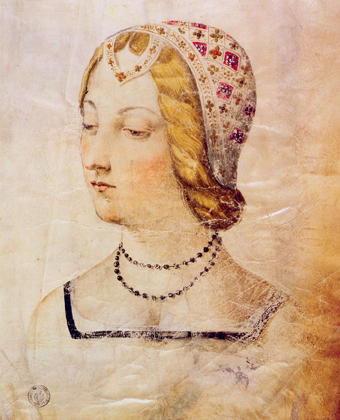
Laura
From then on and until his last breath, he would sing about her. His delicate verses of great elegance and modern intonation, love always being a universal and timeless theme, make him the ancestor of the Romantics as well as the heir of the Provençal singers of courtly love, the troubadours. Alas, in 1348, Laure died of the plague in Avignon.
A lover of Provence
Petrarch divided his time between worldly life and his pleasures at the Court of Avignon and Fontaine-de-Vaucluse, where he had retired to find peace and quiet. He was aware to the charm of nature and the Sorgue, whose banks inspired a famous song.
In his letters, he also wrote about the life and nature of Provence, he spoke of the shepherds and fishermen of the Sorgue and recounted his ascent of Mount Ventoux with his brother Ghérardo in 1335.
Later life
Petrach left Fontaine-de-Vaucluse for good around 1353 for Italy and settled in Aquà Petrarca, near Padua (today twinned with Fontaine-de-Vaucluse).
He was found dead, with his head bent over a manuscript of Homer on 19 July 1374.
He was the first of the great humanists of the Renaissance, scholar, historian, tireless researcher of ancient manuscripts and of course poet ("Canzoniere" and "Triunfi").
The calades of Fontaine-de-Vaucluse
To access the castle, you'll have to first navigate the village's calades, starting with the calade François Pétrarque.

Calade François Pétrarque © French Moments
Visitors enter a very picturesque and lesser-known part of the village to tourists.
The calades are narrow, cobblestoned pathways made of large limestone pebbles.
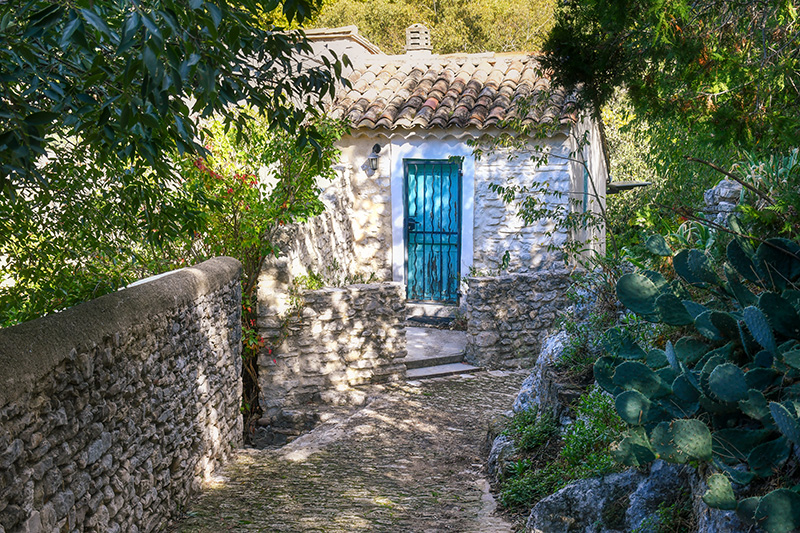
Calade François Pétrarque © French Moments
They provide some fine views of the village's roofs and the chimney of the old paper mills.
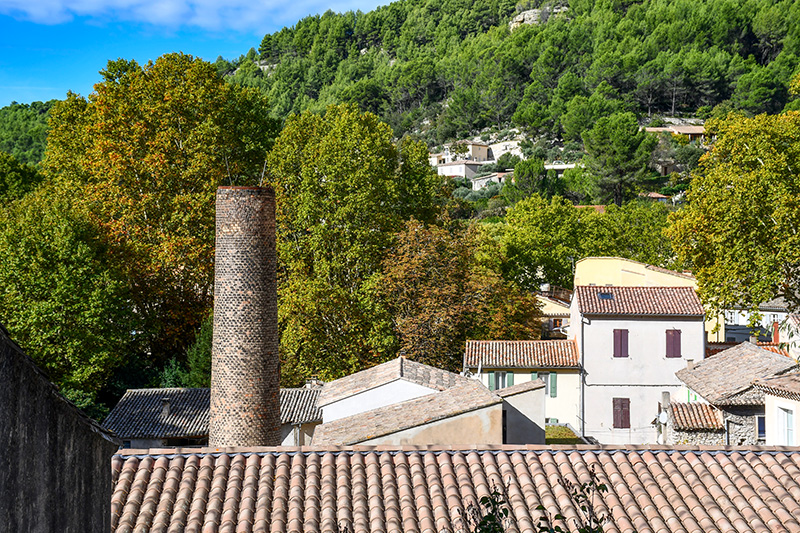
Chimney of a former paper factory (view from the calades) © French Moments
About the access to the castle
It's important to know that the municipality of Fontaine-de-Vaucluse declines all responsibility for accidents during the climb and visit to the castle (and well, I do, too!).
The path is quite rocky and can be very slippery after rain. On my first time climbing to the castle, I was not entirely sure where I was supposed to go. Sometimes, the trail isn't very obvious, and you wonder where it leads. So be careful when ascending to the castle!
The castle of the bishops of Cavaillon
The ruined castle overlooking Fontaine-de-Vaucluse belonged to the bishops of Cavaillon.
A first fortress was built here around 1030, likely at the same time as the village church. A donation deed mentions it in 1034, but the ruins we see today date from the early 12th century.

A view of the castle from the Place de la Colonne © French Moments
The fortress is perched on the immense rocky outcrop that surrounds the Sorgue resurgence.
The castle dates back to the 1030s, but the present ruins date from the early 13th century. It was in this castle that Francesco Petrarca (aka Petrarch) visited his friend, Philippe de Cabassole, bishop of Cavaillon. This is why the castle is sometimes called Petrarch's castle.

Entrance to the castle © French Moments
The castle was declared a ruin in the 17th century, and today, the truncated walls no longer have battlements or machicolations.

Castle of the Cavaillon's Bishops © French Moments
Since the site is only partially secured, one must be very careful. There's always a risk of slipping, falling, or getting hit by a stone.
The plunging view of the village and the valley is absolutely magnificent.
You can recognise the Chemin de la Sorgue that many visitors follow on their way to the source.
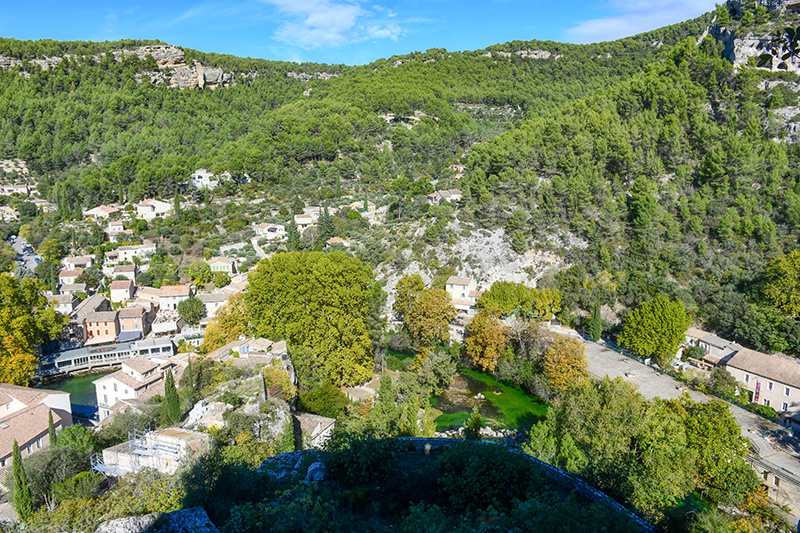
The view from the castle © French Moments

The view from the castle © French Moments
And in the distance, one can see the Comtadine Plain towards l'Isle-sur-la-Sorgue.
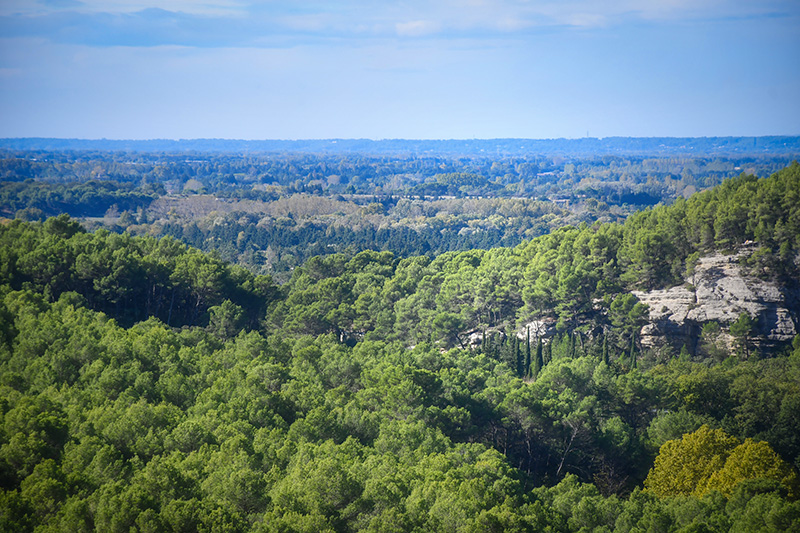
The castle view to the Comtadine Plain © French Moments
Today, the ruins contribute to a most romantic picture in Fontaine-de-Vaucluse.
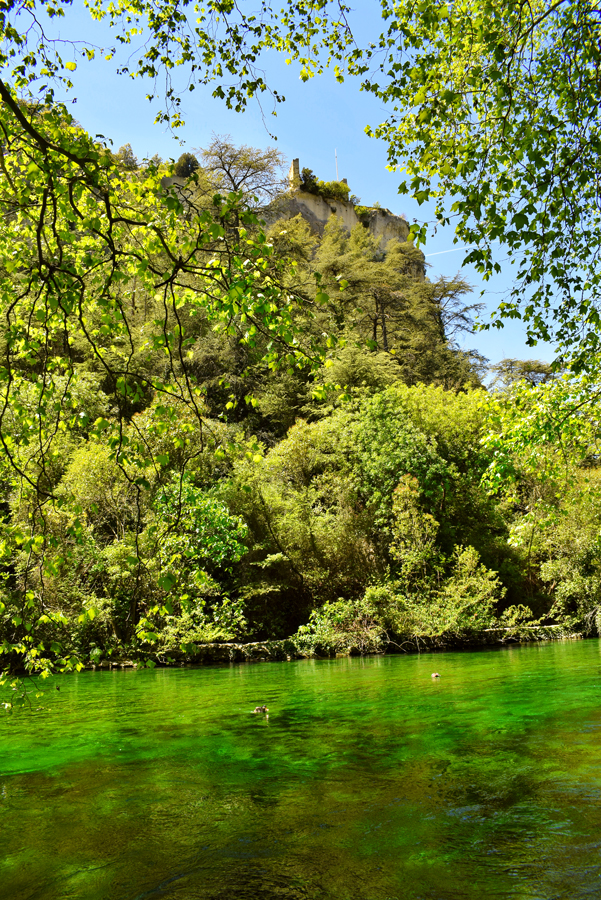
The Sorgue and the castle of Vaucluse © French Moments
The water spring of Fontaine de Vaucluse
A walk to the spring
A visit to Fontaine-de-Vaucluse cannot be done without a visit to the source of the Sorgue.
Follow the Chemin de la Fontaine to discover the famous source of the Sorgue River. From the village, the round trip is about 1.6 km (1 mi) long.
The first part of the path is lined with shops on one side and the river on the other. It's an easy, accessible walk for everyone, with only the last few metres being pebbly.
This is a walk we did in May, when there were few people on the site.
You pass by the tourist shops and you can imagine that this place is very touristy in high season.
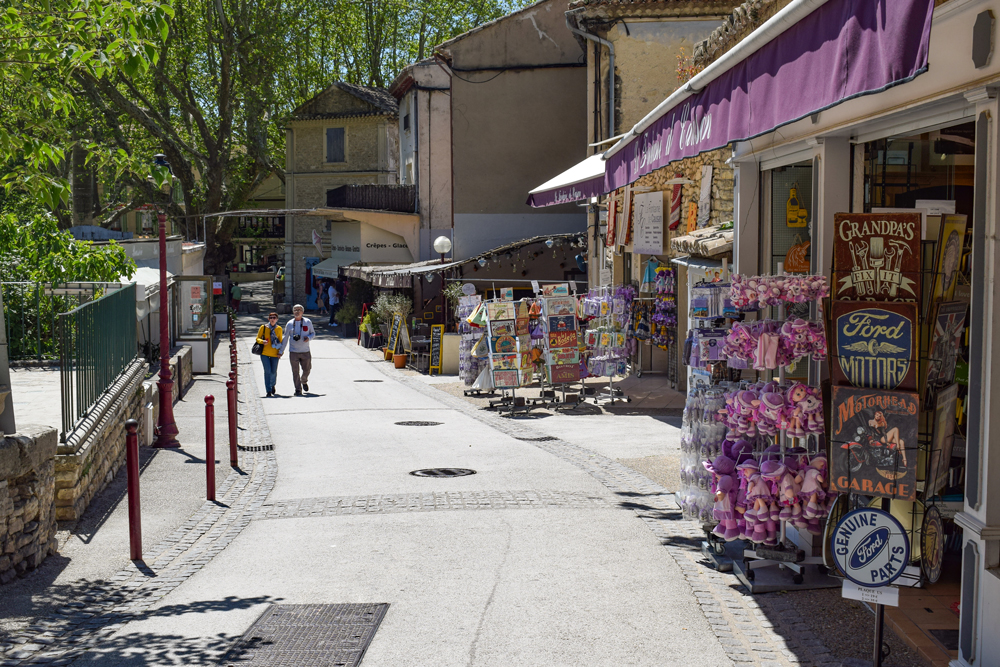
The tourist shops © French Moments
The path follows the course of the Sorgue upstream.
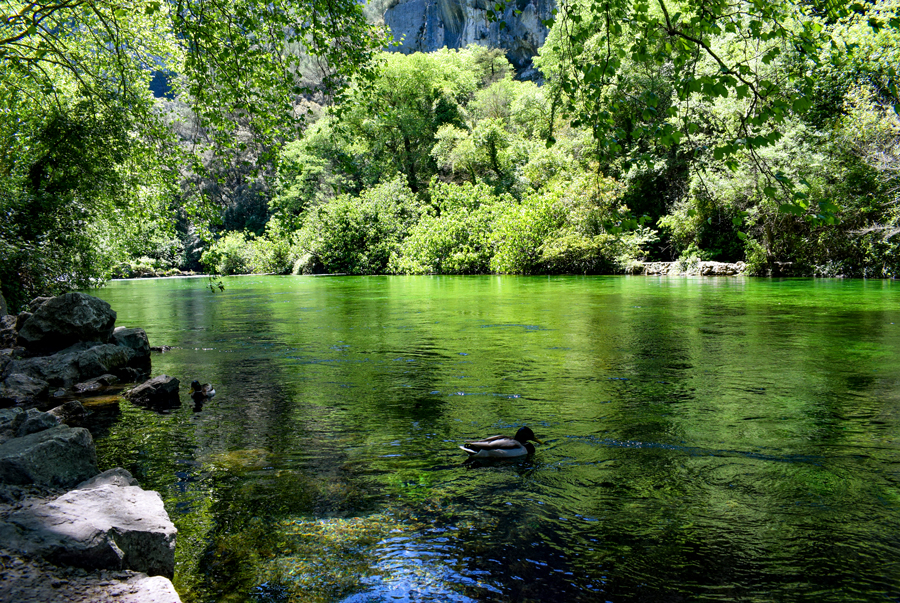
Along the Sorgue © French Moments
The walk took us to a haven of peace where everything was calm and peaceful.
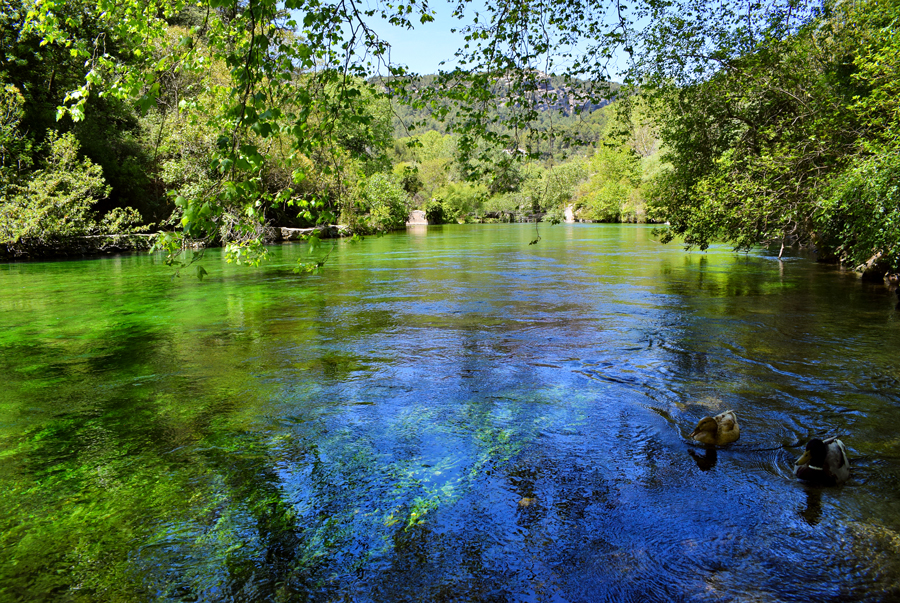
The Sorgue River © French Moments
The forest by the water is made up of centuries-old trees: alder, ash, weeping willow and plane trees.

A walk by the Sorgue © French Moments
As for the water of the Sorgue, it was shallow, of a beautiful turquoise colour and of an incredible transparency. The colour of the water is due to the presence of an aquatic plant, the lesser water parnip.
We enjoyed a snack break by the turquoise waters of the Sorgue.

A little break by the Sorgue river © French Moments
Over the last 300 m, the slope becomes a little steeper and the pebbled path can make it difficult to pass with a pushchair.
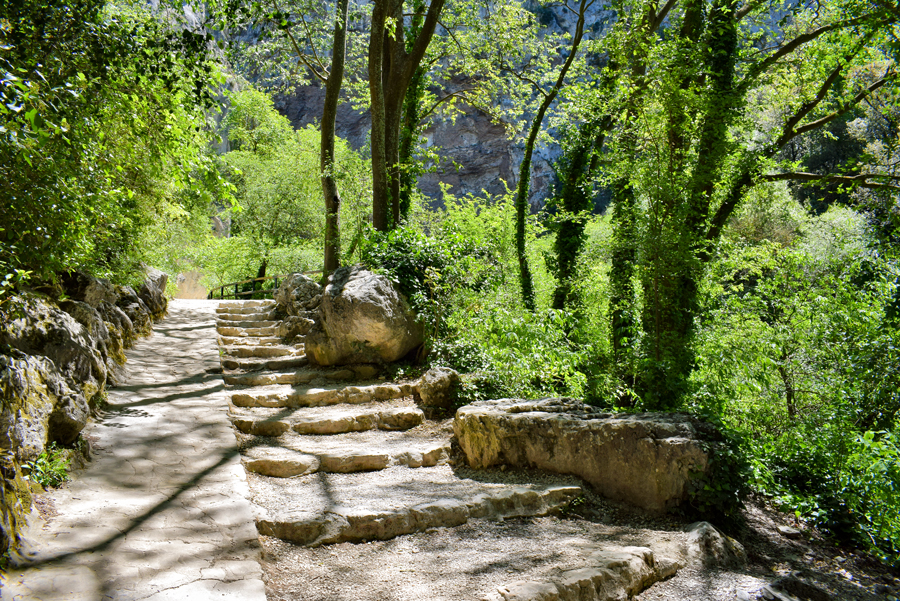
The path leading to the Karst spring © French Moments
A few words about the Sorgue
The Sorgue is a short river of 30 km, entirely contained within the Vaucluse département.
It splits into several branches upstream of l'Isle-sur-la-Sorgue, one of which passes through the city of Avignon and the surrounding countryside before flowing into the Rhône.
Arriving at the Karst spring
The spring is reached at the top of the slope.

At the Karst spring © French Moments
At the time of our visit (May), the spring was at a very low level.
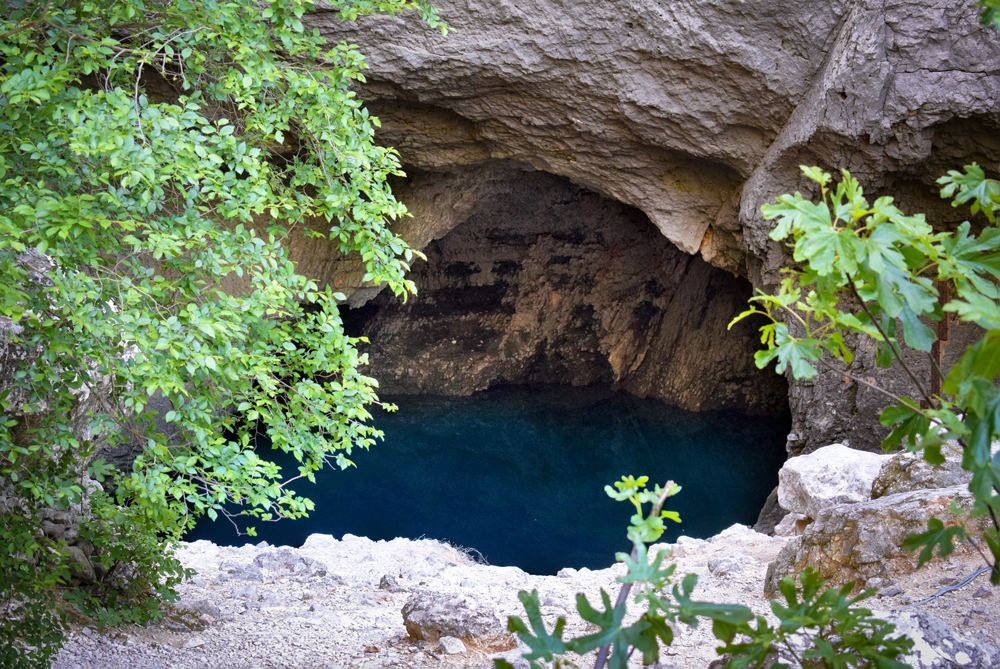
The Karst spring in May © French Moments
In winter and early spring it can look like this:
![Fontaine de Vaucluse © Vi..Cult... - licence [CC BY-SA 4.0] from Wikimedia Commons Karst spring of Vaucluse © Vi..Cult... - licence [CC BY-SA 4.0] from Wikimedia Commons](http://frenchmoments.eu/wp-content/uploads/2012/11/Fontaine-de-Vaucluse-©-Vi..Cult_...-licence-CC-BY-SA-4.0-from-Wikimedia-Commons-scaled.jpg)
Fontaine de Vaucluse © Vi..Cult... - licence [CC BY-SA 4.0] from Wikimedia Commons
So, the best time of year to admire it is in winter, early spring and sometimes autumn. Indeed, the water level depends on the weather, rainfall, or even snowmelt over the past year.
The 'Fontaine de Vaucluse'
The resurgence was named "Fontaine de Vaucluse", like the village downstream (except without the dashes).
At the foot of an abrupt 230 metres cliff, the Fontaine de Vaucluse is the largest spring in France and the fifth largest in the world, with a flow of between 630 and 700 million cubic metres.

The cliffs above the Karst spring © French Moments
The site was a place of ritual offerings in ancient times. Over 1,600 coins from the first century B.C. to the fifth century A.D. were found on the site.
The well goes 305 metres underground and receives the water from Mount Ventoux, the Vaucluse plateau, the Albion plateau and the Lure Mountain. Interestingly, it excludes waters from the Byre Mountain north, the Luberon and the Synclinal of Apt in the south.
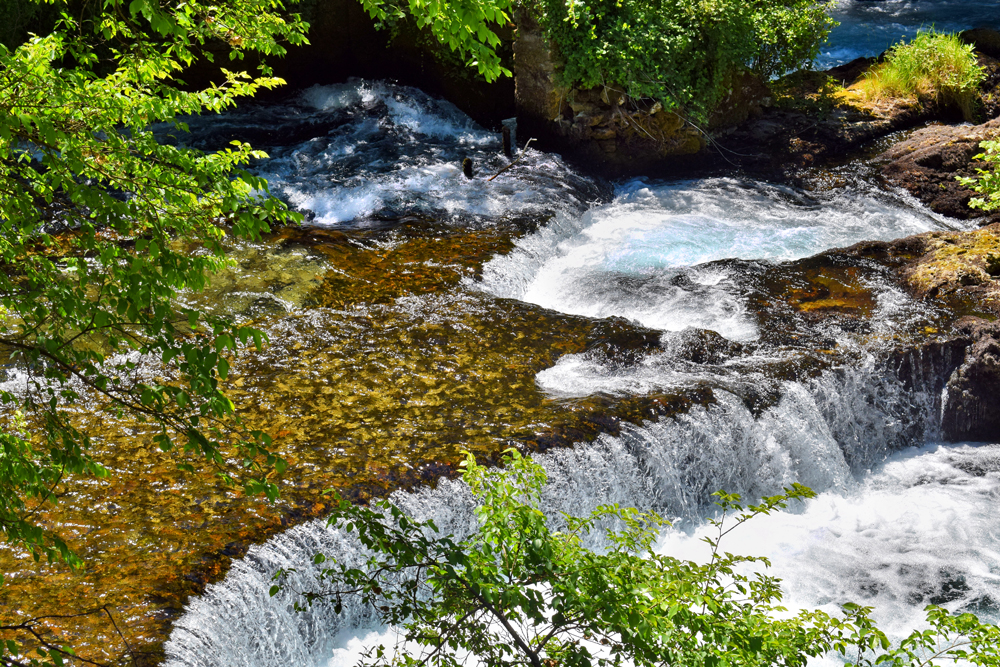
The young Sorgue River © French Moments
These waters gather at a low point to form a very abundant source.
In hydrogeology, this type of source is called a "vauclusian spring" (in French, source vauclusienne).
The Fontaine de Vaucluse is the largest vauclusian spring in France and the fifth largest in the world.
The depth of the cave system remains a mystery. In 1989, the remote-controlled mini-submarine Le Spélénaute reached its deepest point at 315 metres.
Find out more about Fontaine-de-Vaucluse
Holiday accommodation in Fontaine-de-Vaucluse
Fontaine-de-Vaucluse and surroundings have a high capacity for holiday accommodation. The commune has hotels, bed and breakfasts (covering all price ranges), estate agencies offering seasonal rentals and gîtes.
Click here to book your accommodation in the Luberon or browse the map below:
On the blog and other websites
Here are some pages from our blog and other websites to find out more about this Provencal destination.
- Follow my guided walk video of the village on YouTube 🎦
- Discover the hilltop villages of the Luberon
- Find out more about Provence-Alpes-Côte d'Azur
- The official tourist office of the area
What to do in the Luberon
Be inspired by a list of things to do in the Luberon:
Pin Fontaine-de-Vaucluse on Pinterest
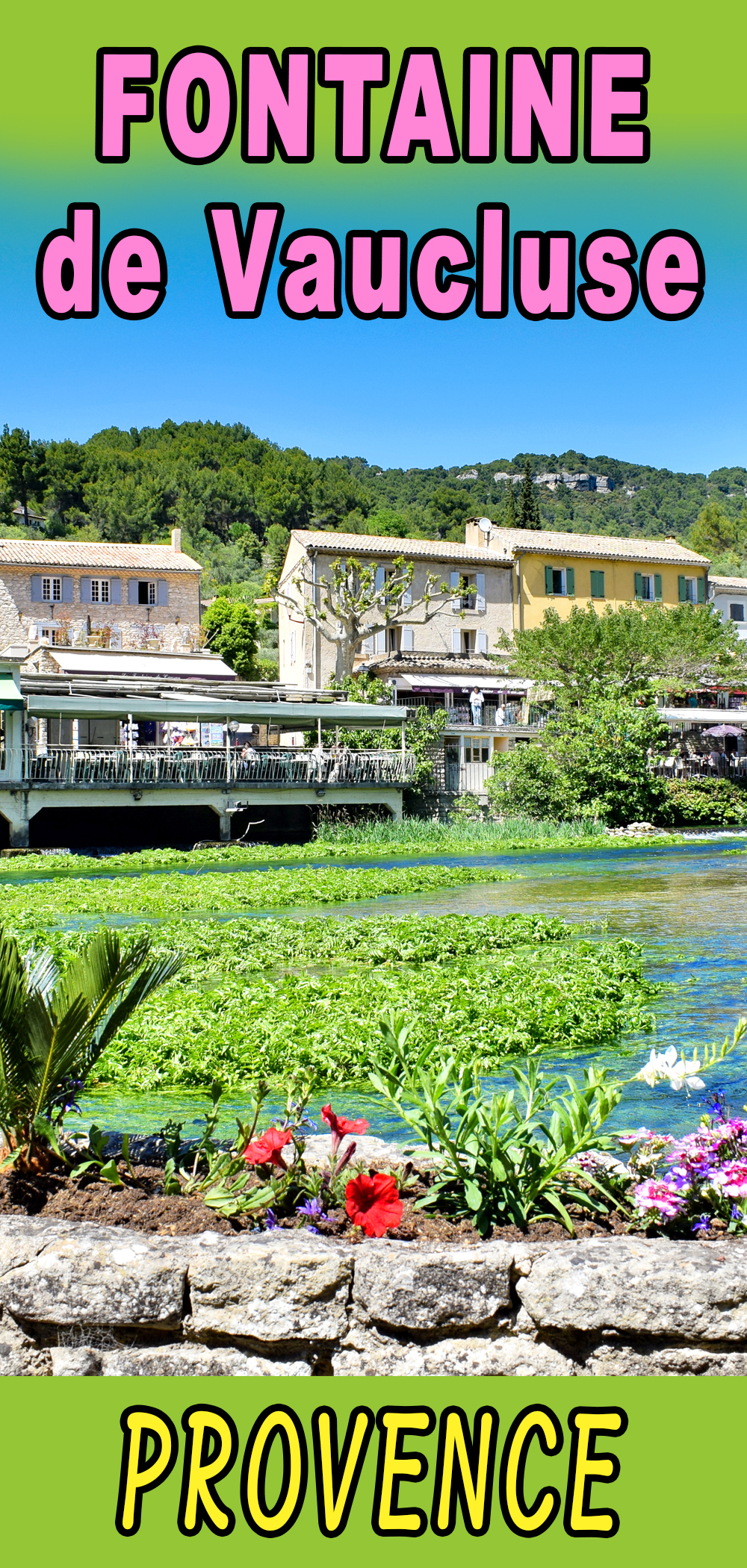
More photos of Fontaine-de-Vaucluse
Here are some photos of Fontaine-de-Vaucluse taken during our last visit in May.
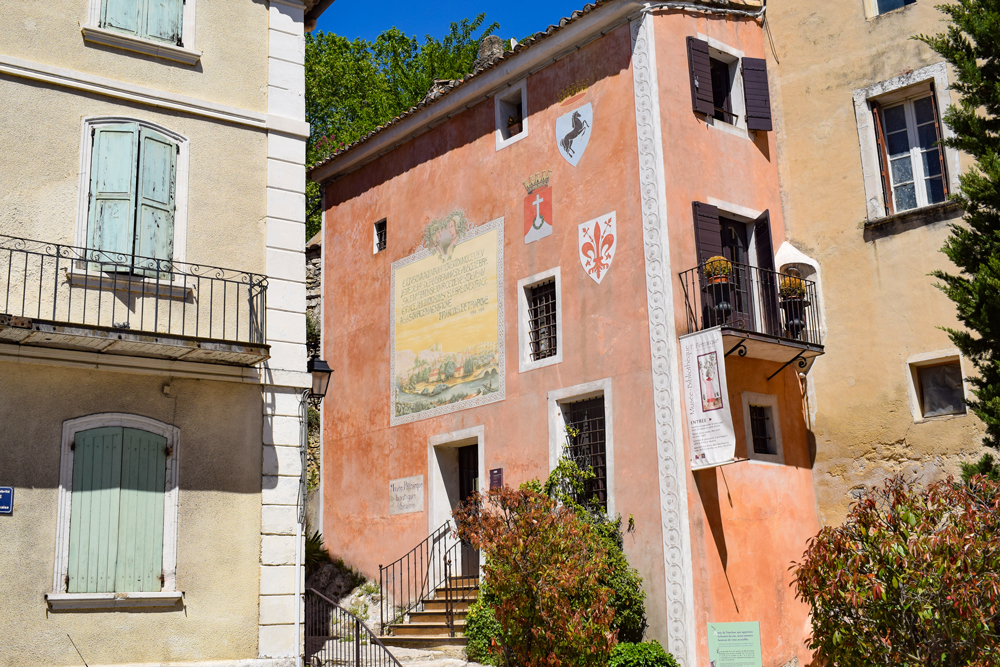
On the right bank of the village © French Moments
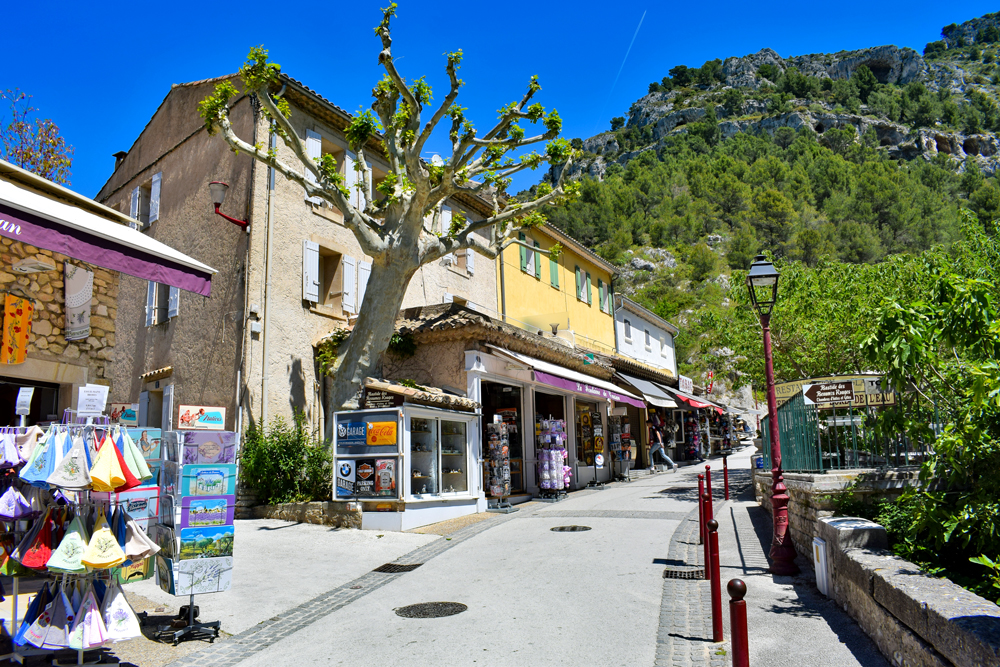
The tourist shops in the village © French Moments
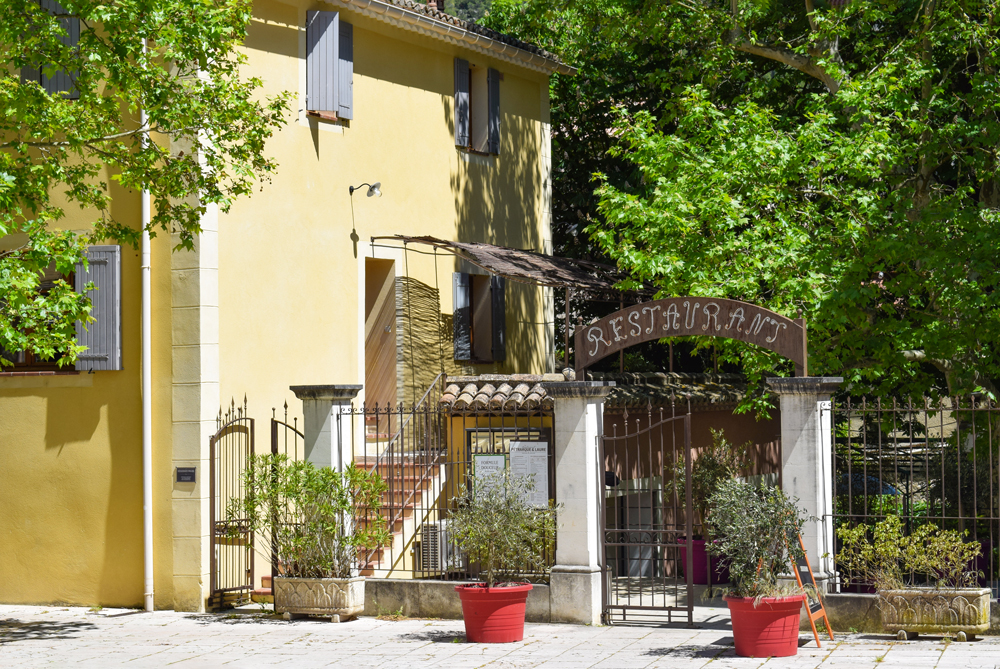
A restaurant in Fontaine-de-Vaucluse © French Moments
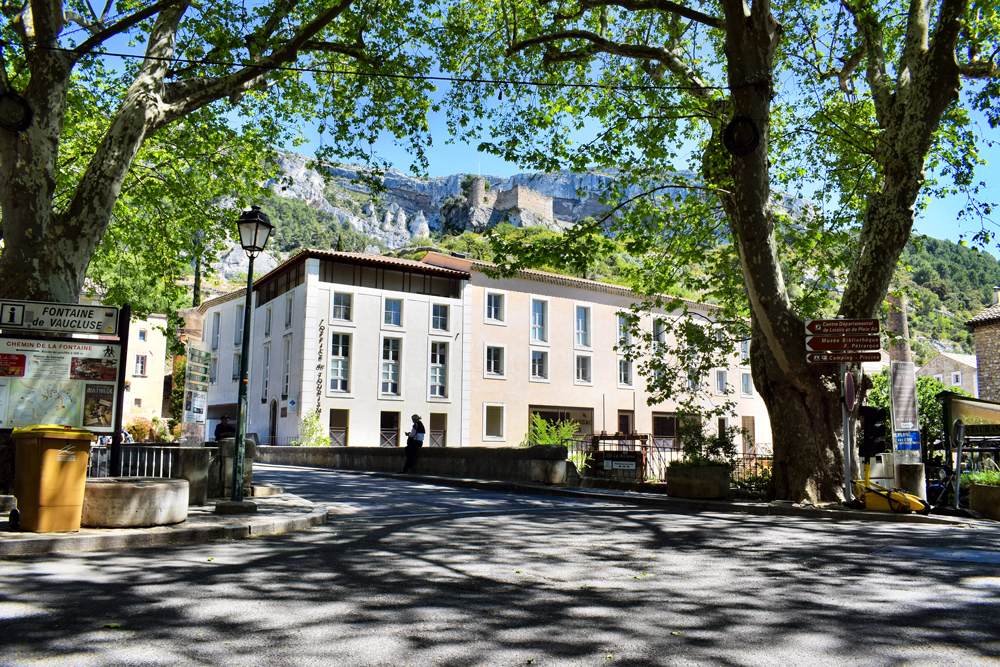
Place de la Colonne © French Moments

The view from the bridge © French Moments

The Sorgue river © French Moments

On the bridge © French Moments
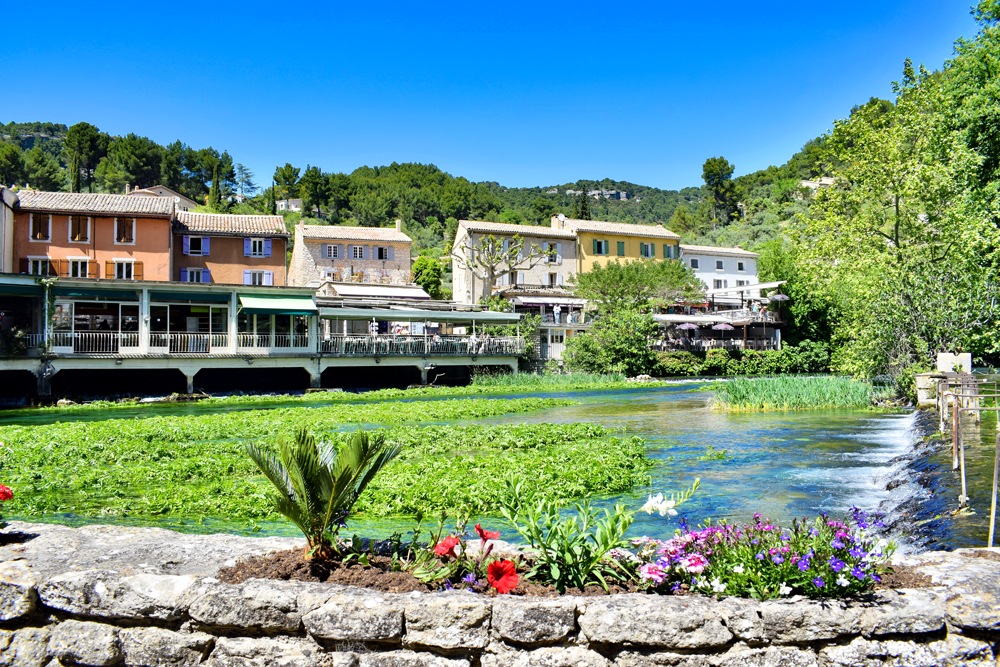
The bridge on the Sorgue © French Moments
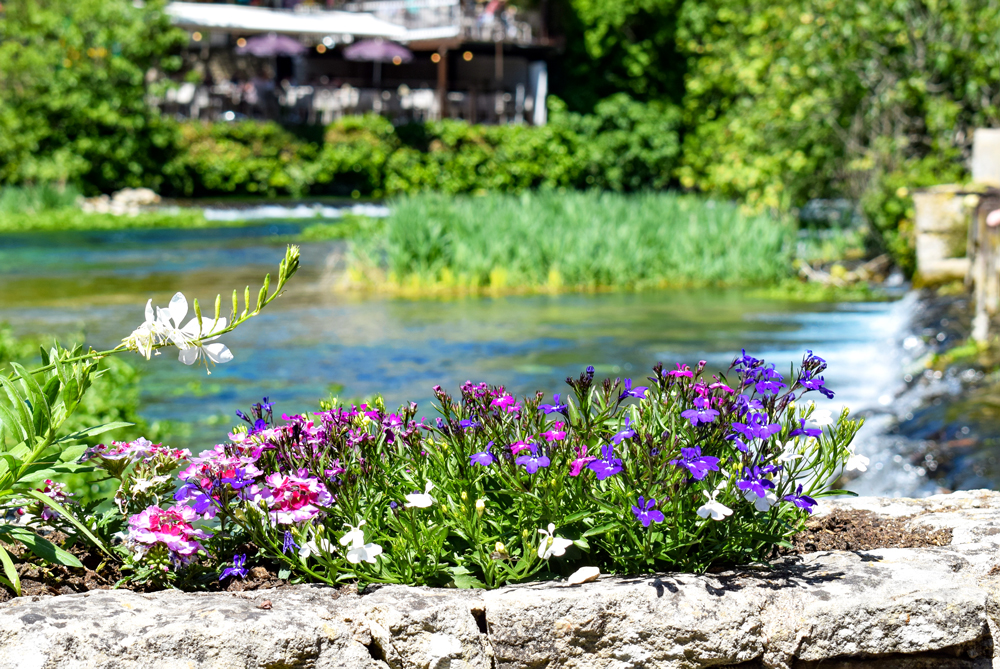
Floral display on the bridge © French Moments

The Sorgue in Fontaine-de-Vaucluse © French Moments
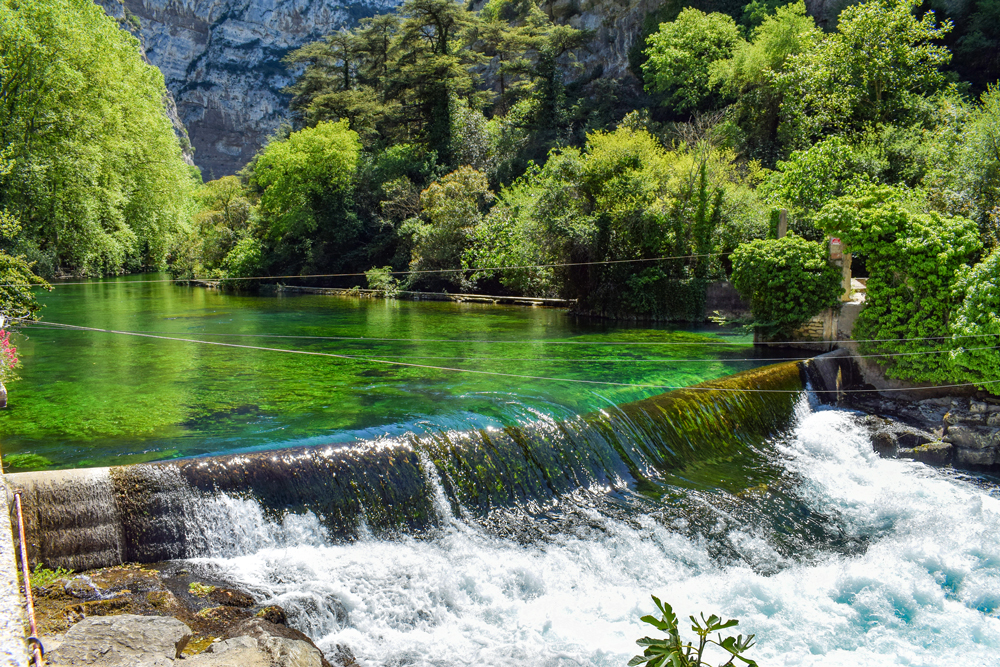
The river Sorgue © French Moments

The formidable cliffs and caves above the village © French Moments




